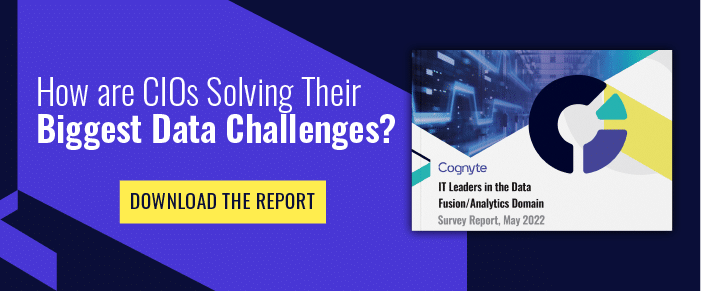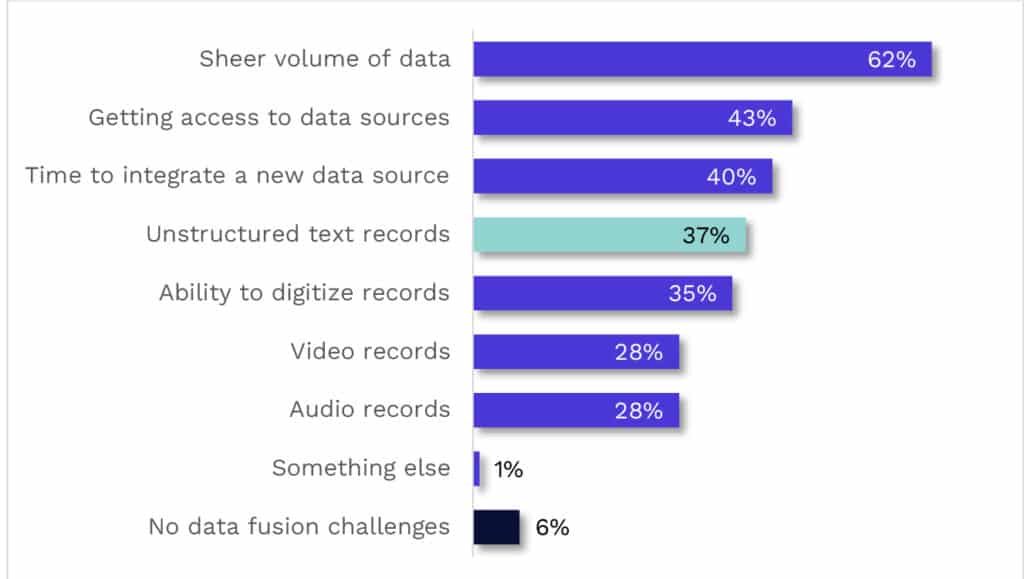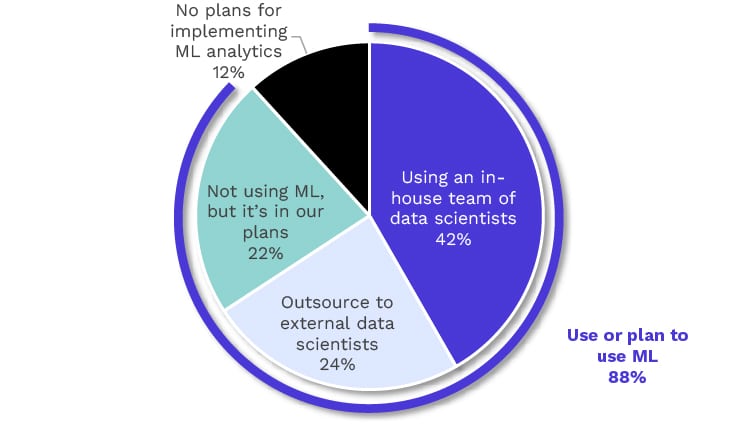2022 Government
CIO Survey Shows
Key Big Data
Challenges and Priorities
As investigation teams in government and security organizations face increased struggles in the big data era, Chief Information Officers (CIOs) must equip their organizations with more powerful tools to conduct investigations, assess risks and mitigate threats. CIOs play a critical role in building the right technology infrastructure and strategy across the organization to ensure that investigators and analysts have what they need to get a full data picture and to generate actionable insights for intelligent decision-making.
It is vital to understand the current challenges facing government and security organizations and the strategies and investments being evaluated by top IT leaders. That’s why Cognyte surveyed over 200 government sector CIOs across 14 countries in Europe, North America, and Asia-Pacific to learn their pain points, roadmaps, and strategies.

The growing volume of data is a huge challenge for government sector CIOs
Much of our lives are conducted on the web, on our phones, and through technology. All these interactions and transactions are producing data, causing the volume of data to explode. IDC estimates that the size of the Global Datasphere will reach 175 zetabytes in 2025, up from 20 zetabytes in 2010. IDC defines the Global Datasphere as quantifying and analyzing the amount of data created, captured, and replicated in any given year across the world. Government and security organizations need to tap into many sources of data to conduct investigations, but the scale and siloed nature of these data sources poses significant technological challenges when it comes to fusion and analysis.
Data fusion is a key capability for investigation teams, who need to construct a unified view of thousands or possibly millions of data points. For example, when investigating a criminal organization, law enforcement will need a holistic view of all the suspects, their movements and locations, financial transactions, criminal records, tax records, locations, social media activity and much more.
This sector challenge is huge, with 62% of CIOs naming the sheer volume of data as their main data fusion challenge for investigation purposes.

The data problem is not simply scale, but also scope. Investigations are becoming increasingly multi-disciplinary, creating additional challenges for technology departments working to provide solutions that fuse data and transform them into decisions
Siloed data sources: Investigation teams require data from multiple sources, including government databases, open-source intelligence, reports from different departments, and much more. Technology teams often struggle with integrating all these sources in a cohesive way while facilitating the ability to collaborate between teams.
Diverse data types: Data sources include text files, audio clips, videos, etc. They can be structured or unstructured. Organizations struggle in creating unified entity or event maps given the disparate nature of this data.
CIOs are implementing machine learning to generate analytical insights
New decision intelligence platforms leverage advanced analytics, including machine learning, as a means of analyzing big data. Advanced analytics enable investigative teams to easily identify and visualize connections between suspects, organizations, companies, bank accounts and more as well as spot patterns and anomalies, score risks, highlight suspicious indicators, and ultimately predict threats. This modern decision intelligence platform helps transform data into decisions.
An example of where advanced analytics might be useful is in the context of drug trafficking. An investigation may focus on an individual who is known to be a criminal. Information from different sources can show that he has had interactions with a previously unknown individual, thus highlighting a hidden connection of a new suspect who might be involved in the trafficking ring. If this connection commits certain suspicious behaviors, like making large bank deposits, a trigger may be set up to investigate this new lead.
88% of CIOs report that they are already using machine learning, or it is on their organization’s technology roadmap.

Building the infrastructure for machine learning can be complicated and expensive, with many organizations lacking the personnel with the right skillset needed to build and implement the solutions. CIOs are increasingly looking to adopt off-the-shelf digital intelligence solutions. This platform approach can be easily integrated with a limited internal IT team or system integrators and costs an average of one-third less as compared to developing in-house solutions, according to our survey.
Want to read the full CIO 2022 big data challenges survey?
Our comprehensive report covers the highlights above, plus much more, including:
- CIO investment priorities regarding data fusion
- Trends toward cloud migration
- Strategies for solving data pains and implementing solutions
Download the full survey here.